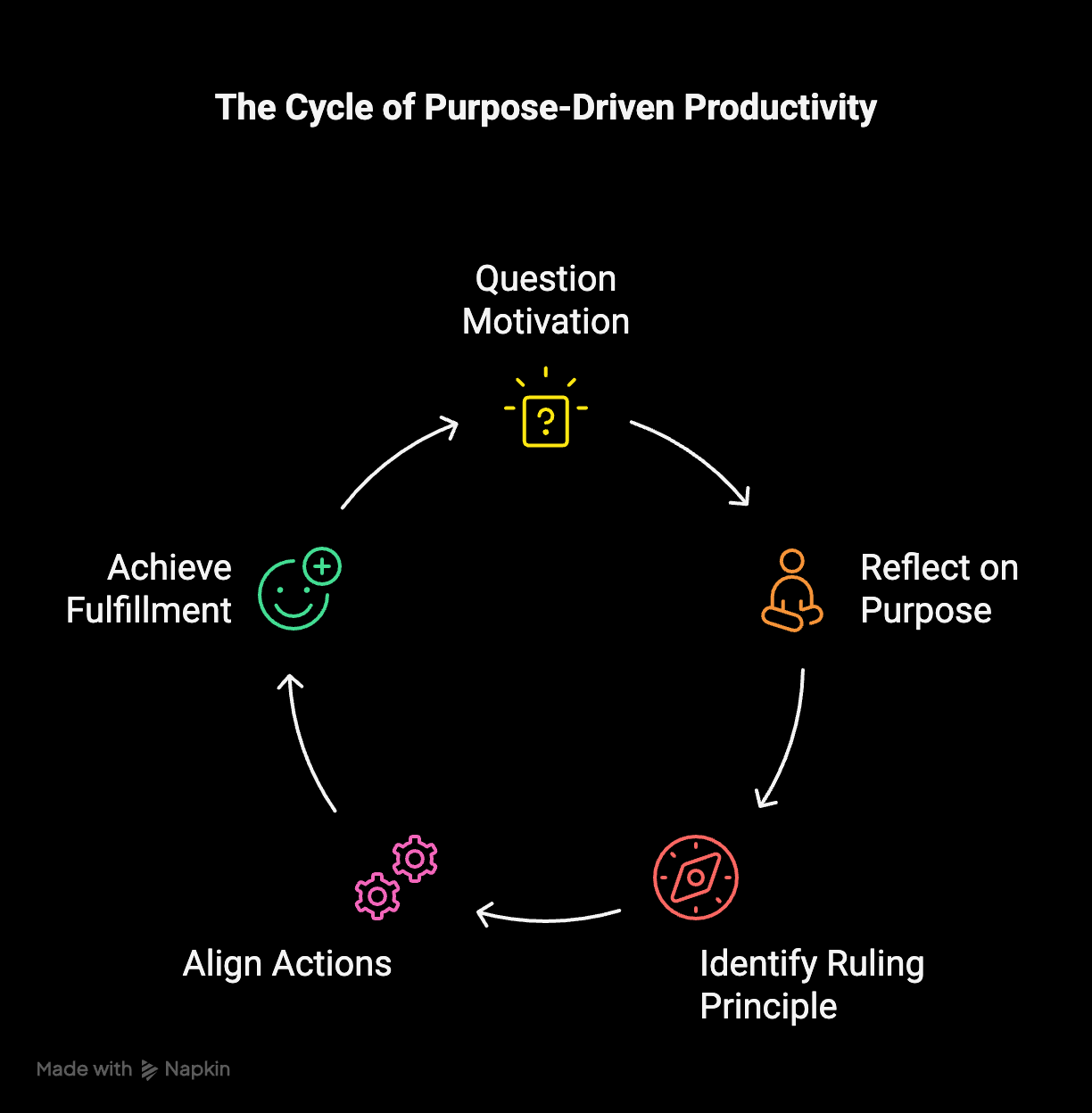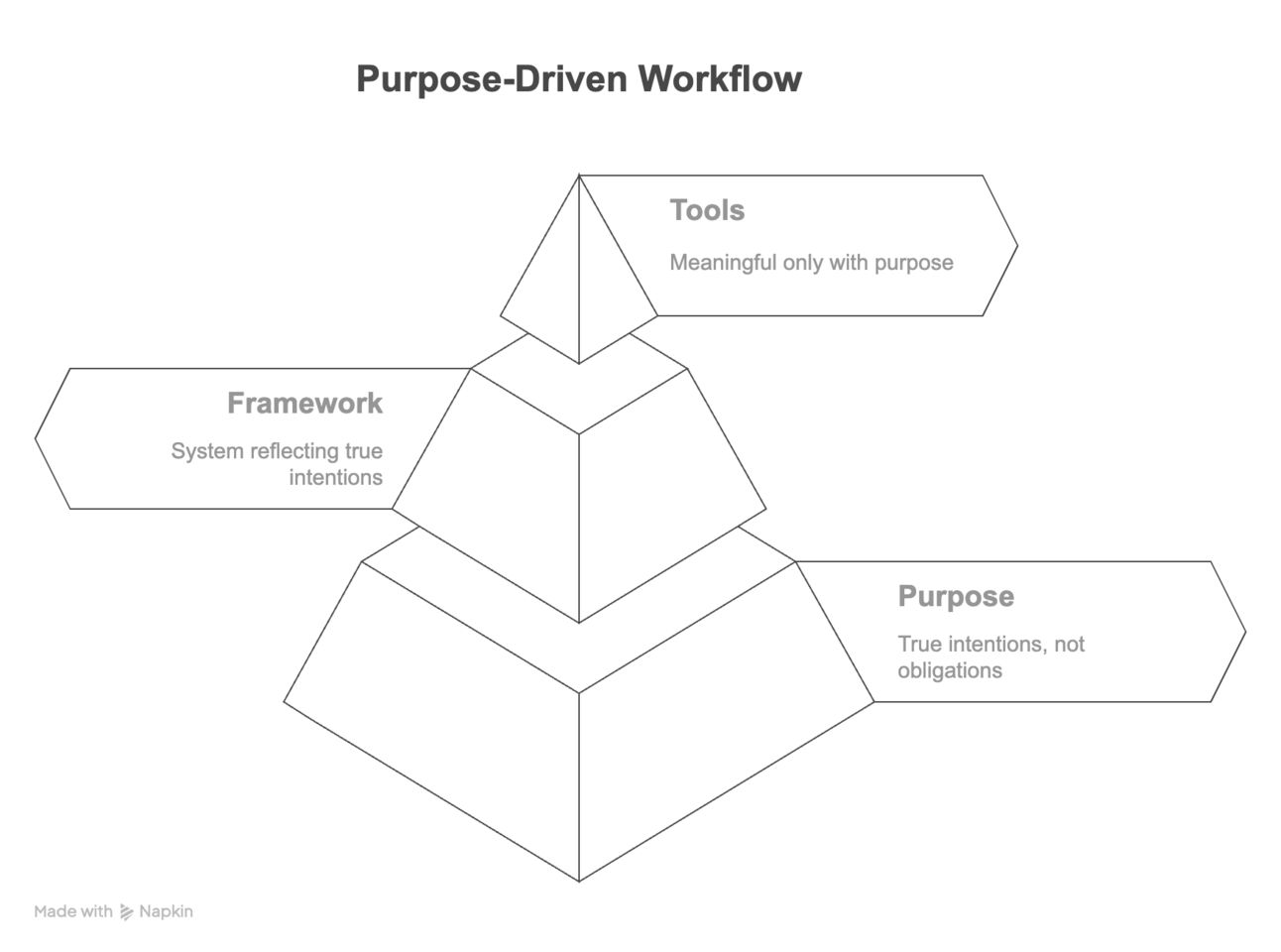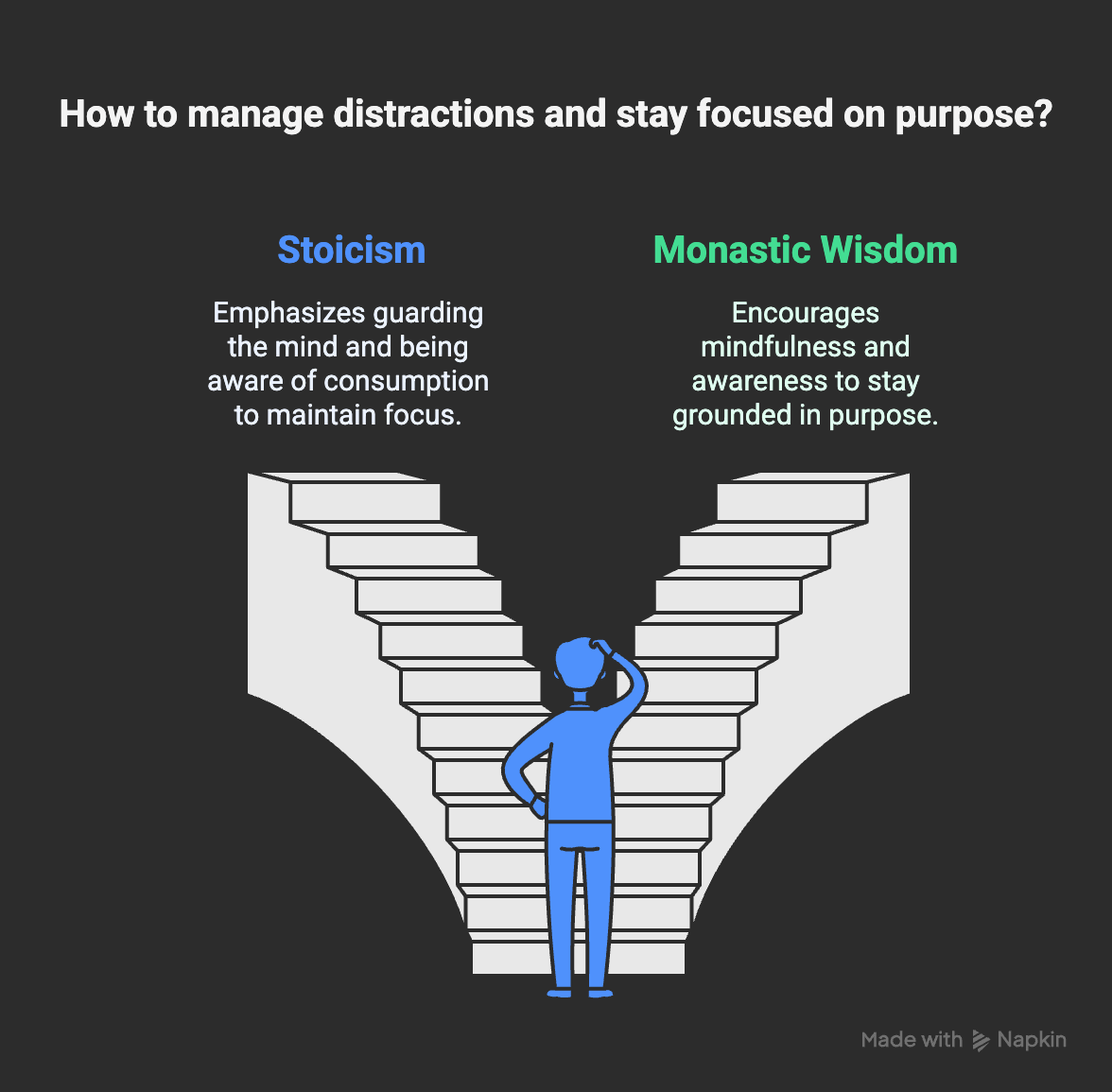- Continuous
- Posts
- Productivity with Purpose
Productivity with Purpose
Connecting Action to Your “Why”
Introduction: The Productivity Trap and the Purpose Gap
There’s never been more advice about productivity—apps, checklists, hacks, and color-coded calendars promising to make us more efficient. Yet, beneath the surface of that non-stop optimization, a simple, unsettling question lingers: why doesn’t any of this make me feel more fulfilled?
Here’s what I’ve noticed. We chase systems. We seek the “perfect” tool, thinking that if we just arrange our lives right, everything will fall into place. But busyness isn’t the same as meaning. As Seneca warned long ago:
"How many have laid waste to your life when you weren’t aware of what you were losing, how much was wasted in pointless grief, foolish joy, greedy desire, and social amusements—how little of your own was left to you."
If you’ve ever ended a productive day feeling oddly empty, this is for you. What’s missing, I believe, isn’t discipline or strategy—it’s purpose. Productivity without purpose is motion without meaning.
So let’s slow down, and ask: What if your daily to-do list could pull you closer to your deepest values? What if getting things done wasn’t just a race, but a way to live your “why” in real time?
Discovering Your Personal Why: Foundation Before Framework
Everything changed for me when I stopped asking “How can I get more done?” and started asking, “Why do I want to get anything done at all?” This is where the productivity game gets real.
But what exactly is your “why?” Call it a ruling principle, your dharma, or just your North Star—this is the unshakeable truth that sits beneath all your choices. It’s not always easy to pin down. Sometimes, it’s only in moments of quiet reflection or discomfort that it surfaces.
Marcus Aurelius gets right to the point:
"An important place to begin in philosophy is this: a clear perception of one's own ruling principle."
And I’ve found that the most powerful productivity doesn’t start with a new app—it starts with knowing yourself.
"Knowledge—self-knowledge in particular—is freedom." (The Daily Stoic)
Ask yourself: What would I regret not pursuing? What brings me alive—outside of anyone else’s expectations? For monks, this is dharma—the intersection of your talents, your passion, and how you can serve. For you, it might be creating, learning, helping, building—or something beautifully unique to you.
Take a moment. Reflect. Journal. Do the inner work before you even bother with systems.
Prompt: What core motivation or value, if truly honored, would make your efforts worthwhile—even if no one else noticed?
For me, a core motivation is opportunity for creative thought. I look for ways to blend creative solutions with otherwise analytical or logical projects. This blend satisfies my internal need to learn, grow, and have fun with what I spend my time and energy on. Even if it is a minor thing like a font choice that maybe most people do not notice, it still makes a difference to me.
For my why for starting Continuos, read here.
Evaluating Productivity Advice Through the Lens of Purpose

Not every productivity tip deserves a place in your life. Honestly, most don’t.
Here’s the truth you rarely hear: A lot of hacks and methods are just the “leaves” of the tree. They’re surface-level, helpful as tweaks, but useless if they don’t connect to the roots of what matters to you. I’ve fallen for this more than once.
The Stoics put it in striking terms:
"If our lives are not ruled by reason, what are they ruled by? Impulse? Whim? Mimicry? Unthinking habit?" (The Daily Stoic)
Jay Shetty, in Think Like a Monk, echoed this lesson:
"Already I was being taught the most important lesson: to focus on the root of things, not the leaf of the tree or symptoms of the problem."
So before you buy into a new system, pause. Ask yourself: Does this move me closer to my why, or just make me look busy?Does this tip give me more of what I value, or just leave me exhausted?
As Epictetus advised, “Trust, but verify.”
Filter everything, yes, even my advice, through your own deeper purpose.
Blueprinting Your Personalized Workflow
Once you’re clear on your why, it’s time to reimagine your workflow. No more chasing other people’s priorities. No more getting seduced by tasks that look important but feel empty. It’s all about building a system that reflects your true intentions, not just your obligations.
I used to believe the answer was finding the perfect tool—the all-in-one note app, the right to-do list, the latest productivity hack. But the truth is, tools are only as meaningful as what you put into them. The order of operations matters: purpose first; framework second.

Seneca’s wisdom cuts through the noise:
"There is clarity in simplicity. While everyone else is running around with a list of responsibilities a mile long… you’ve got just one thing to manage: your choices, your will, your mind. So mind it."
Your mind will shape your systems and, in turn, your days:
"Your mind will take the shape of what you frequently hold in thought, for the human spirit is colored by such impressions." —Marcus Aurelius
How do you operationalise this? Anchor your habits to your why. Use rituals—a morning check-in, a weekly reflection, a brief end-of-day journal (even just a couple minutes). Log not just what you do, but why you did it. Every tool you use—Apple Notes, Kortex, a legal pad—should be at the service of what matters most to you.
I’ve found the real trick isn’t doing more. It’s doing less, but doing it deliberately. Simplicity buys you clarity. As the monks say:
"This ritual requires you to live a simple life… Focus only on your priorities, those activities that are truly meaningful." —The Monk Who Sold His Ferrari
Reflection prompt:
What "leaves" can you prune from your workflow? What routine, meeting, or commitment could you let go of, to create space for what aches to grow?
If only knowing your purpose and setting up rituals was enough. But life is noisy. Distractions, doubt, comparison, and FOMO (fear of missing out on “better” tools or styles) creep in. There's always a new productivity system whispering, “Maybe I'm the answer.”
This is where both Stoicism and monastic wisdom shine. They remind us to guard the gates of our mind, to bring awareness to what we consume—not just physically, but digitally and mentally.

"You’ll never complete all your tasks if you allow yourself to be distracted with every tiny interruption. Your attention is one of your most critical resources. Don’t squander it!" —The Daily Stoic
The real threat isn’t busyness—it’s forgetting what matters amidst the busyness. As Marcus Aurelius wrote:
"Drama, combat, terror, numbness, and subservience—every day these things wipe out your sacred principles, whenever your mind entertains them uncritically or lets them slip in."
The monks remind us to notice the “weeds” that creep into our mental garden:
"When you control your thoughts, you control your mind. When you control your mind, you control your life." —The Monk Who Sold His Ferrari
Here’s what helps me:
End-of-day reflection. Did today’s actions reflect my highest values, or merely my inbox?
Rituals of solitude. Even five minutes of quiet can reconnect you to your compass and its possible, even with a 4-year old questioning your simple explanation for why drawers have handles.
Opposition thinking. Notice a negative loop (“I’m falling behind, I need a new system!”)? Pause, breathe, and gently focus on your intention instead.
Prompt:
What is the single biggest distraction I allow into my day? What would it look like to pause, even for a moment, and choose differently?
Letting Purpose Drive Your To-Do List
So how do you make your “why” visible in the real world? The answer is beautifully mundane: translate meaning into action, one next step at a time.
In GTD (Getting Things Done), it’s all about clarity—knowing what “done” looks like and what “doing” looks like. But clarity is only power if it’s aligned. Let your why be the filter for what you capture, what you clarify, and what you actually execute.
"Let us therefore set out whole-heartedly, leaving aside our many distractions and exert ourselves in this single purpose, before we realize too late the swift and unstoppable flight of time." —Seneca
On a practical level, I regularly ask myself:
What’s the one thing, if accomplished today, would feel most meaningful—not just most urgent?
When I scan my upcoming week, what’s missing that would move me toward my purpose, not just toward feeling caught up?
As the Stoics so simply put it:
"Here is how to guarantee you have a good day: do good things."
That’s it. Purpose, then action. Clarity, then courage.
The Payoff: Fulfillment Over Mere Achievement
The rewards of this alignment are real. Far less stress. A sense of direction that doesn’t wobble with every latest trend. An energy that’s subtly deeper, because you’re moving toward the life you want—not just the life someone else designed.
"Complete the projects you begin, fulfill the commitments you have made, live up to your promises—then…you can have success, which leads to a feeling of fulfillment, worthiness and oneness." —Getting Things Done
So here’s the real secret of productivity: it isn’t about doing the most. It’s about doing what matters—again and again and again. It’s about becoming, a little more each day, the person you’ve always meant to be. That’s a journey worthy of your best systems, of your deepest attention, and of all your heart.
Key Takeaways
1. Productivity Alone Isn’t Fulfillment
Tools, hacks, and busyness don’t guarantee meaning or satisfaction.
Many feel unfulfilled despite checking off tasks—what’s often missing is purpose.
2. Start with ‘Why’
Asking why you want to be productive is more important than how to be productive.
Your “why” is your core motivation, value, or ruling principle (your North Star).
Take time for self-reflection (journaling, quiet time) to uncover what truly matters to you.
3. Evaluate Advice Carefully
Not all productivity tips or systems are worth adopting; many are superficial.
Only use tools and methods that connect to your core values and help you fulfill your purpose.
4. Build a Personalized Workflow
Let your purpose shape your workflow and habits, not the latest trends or peer pressure.
Focus on simplicity and intentionality—do less, but do it deliberately.
Anchor workflows to your “why” through rituals (e.g., morning reflections, end-of-day check-ins).
5. Manage Obstacles: Distraction, Doubt, Drift
Distractions and digital noise can pull you away from meaningful work.
Use rituals and regular reflection to keep your mind aligned with your values.
Be aware of mental “weeds” and practice choosing intention over impulse.
6. Let Purpose Drive Action
Filter daily tasks and commitments through your “why.”
Prioritize meaningful actions, not just urgent or routine ones.
Regularly ask what one thing, if accomplished, would feel most fulfilling.
7. Fulfillment Over Achievement
True success is completing what matters, not just what’s on your list.
A purpose-driven approach yields less stress, more energy, and deeper satisfaction.
Productivity is about becoming who you want to be, not just doing more.
Productivity is most powerful when anchored to purpose. Start with your “why,” shape your systems to support it, prune distractions, and let your action flow from what matters most to you.
Reflection: This week, what’s one action you could take—not because you have to, but because it calls to you? Start there.